This past week Zwift announced a number of updates for their hardware. While I got slightly behind this week (more on why in the next few weeks, fear not, it’s all good!), I wanted to touch on this. If for no other reason than having a historical post to reference down the road. I think elements of this are actually a pretty big deal in the indoor cycling hardware space, as will become evident in time.
In any event, these updates are as follows:
1) Zwift Frame is now available for standalone purchase
2) Zwift has clarified the initial batch of trainers compatible with it
3) Zwift has released the new Zwift Cog 2.0, which adds an indexing system to make it quieter
4) Zwift formally announced the Zwift Ready program
All of these things had various teasers/etc over the course of the summer, but now they’re all Facebook Official, and some of the details like pricing and compatibility are more concrete. Equally notable, Wahoo has also updated their indoor trainer & smart bike pricing (lower), more on that in a separate post just after this.
Let’s get into it.
Zwift Frame Standalone:
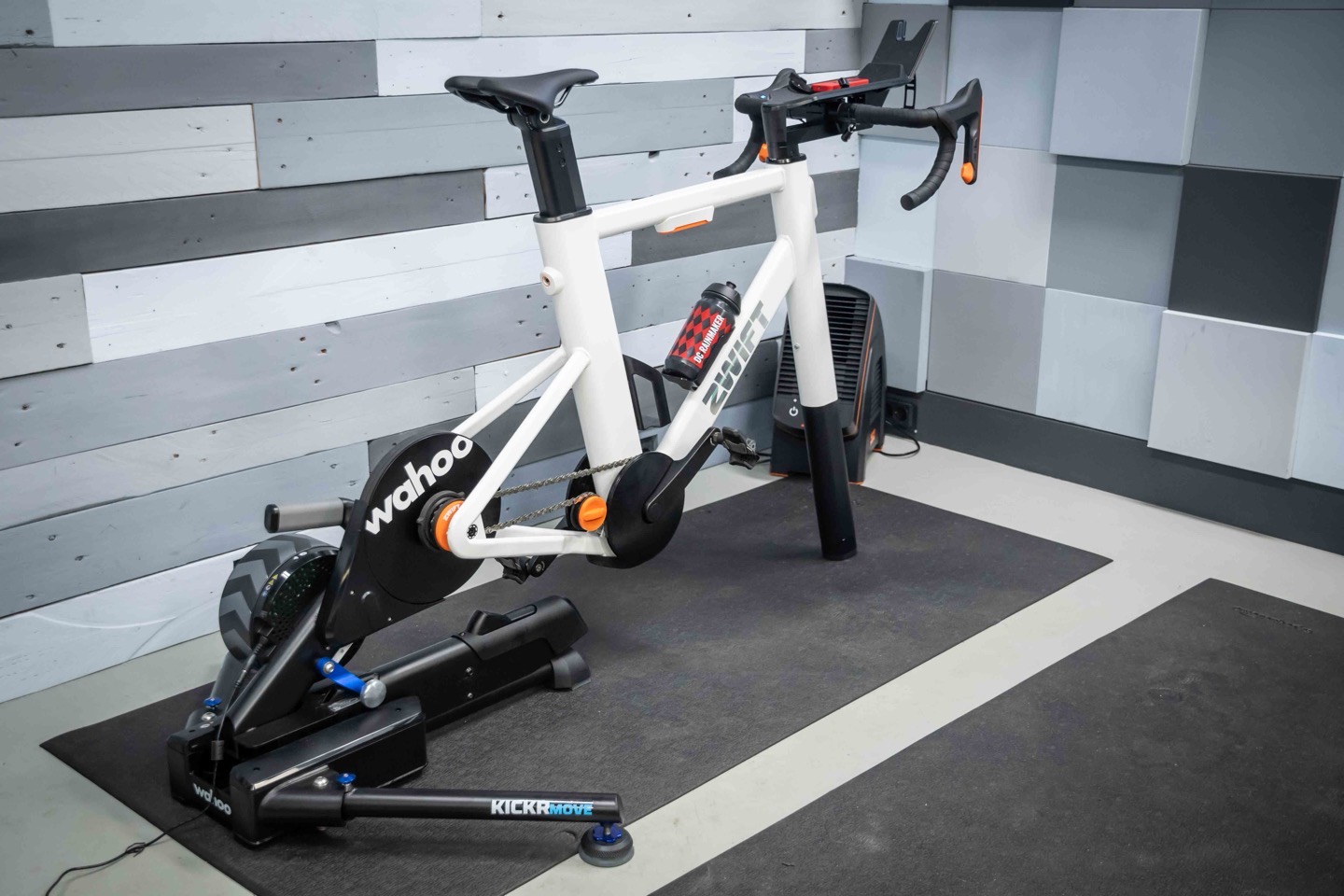
The most significant news of today is that, as promised at launch, the Zwift Ride Frame is now available in a standalone purchase configuration. This means that if you’ve already got a compatible trainer, you can simply buy the Zwift Frame and attach it to your trainer. Part of that Zwift Frame kit includes both a new Zwift Cog V2 (which actually didn’t ship on the Zwift Ride when it started shipping back in June), as well as a new adjustable ‘foot’ for the pirate-style peg-leg of the Zwift Ride Frame (to account for various heights of differing trainers).
The pricing is $799.99/€799.99/£749.99. The tablet holder is an additional $49. Shipping the Zwift Frame for a US address I gave it, was $55.
At present, the frame-only option is only available in US/UK/EU, whereas the Zwift Ride + KICKR CORE bundle is available in Canada/Australia/Japan (as Wahoo is handling logistics there). Obviously, long term Zwift will need to sort out something for Zwift Frame in other markets (ideally before northern hemisphere winter, but who knows).
As of launch, the following trainers are compatible with it:
– JetBlack Victory with Zwift Cog and Click
– Wahoo KICKR CORE Zwift One
– Wahoo KICKR V6 with Zwift Cog and Click
– Wahoo KICKR MOVE with Zwift Cog and Click
– Zwift Hub (all versions)
In the case of the Wahoo KICKR MOVE, it’s only usable in a ‘locked’ (non-moving) configuration. Though clearly, it’ll take someone creative (probably GPLama) one trip to the hardware store to find a rolling caster for that. The rubber piece is kinda beefy, so it should be very doable (and obviously, the best kind of Lama sketchy).
And then starting later this winter, you’ll see a few more added to the list:
– Elite Direto XR with Zwift Cog and Click
– (Decathlon) VAN RYSEL D100 with Zwift Cog and Click
Over time we’ll probably see other brands/models added to this list, as those brands work with Zwift to come to an agreement on utilizing the Zwift Cog. Many brands are concerned with the implications of that, as the Zwift Cog is *NOT* compatible with 3rd party apps that use simulation mode (e.g. simulating a given gradient). Thus, if you wanted to use a trainer with the Zwift Cog on an app like Rouvy, Kinomap, Kool, Tacx Training App, and more – that’s simply not possible. Only ERG-mode apps are still compatible (e.g., TrainerRoad, or Wahoo SYSTM, or Indievelo, because they don’t need any sort of virtual shifting capability.)
In any event, setting aside that debate, the Zwift Frame standalone package will include:
A) The white frame itself (including handlebars/etc…)
B) The Zwift Cog 2.0 for your trainer
C) An adjustable front foot, to find the correct height for your trainer
In fact, if you were to look at my initial unboxing of the Zwift Ride setup/unboxing section, that’s pretty much exactly what I originally got, and then I paired it with an existing KICKR CORE that had a Zwift COG (V1.1) on it. This simply goes with the new V2 COG, outlined below.
In the box are two different feet to choose from, a shorter one, and a taller one. They connect into the base of the front leg:

By default, the existing Zwift Ride frame (package) comes with the smaller one pre-installed. Below, you’re looking at the included orange hex wrench, where you’d screw/unscrew the foot into the frame. There’s basically two parts: A rubber piece, and a plastic piece. The rubber piece is what I’m showing you the differences of.
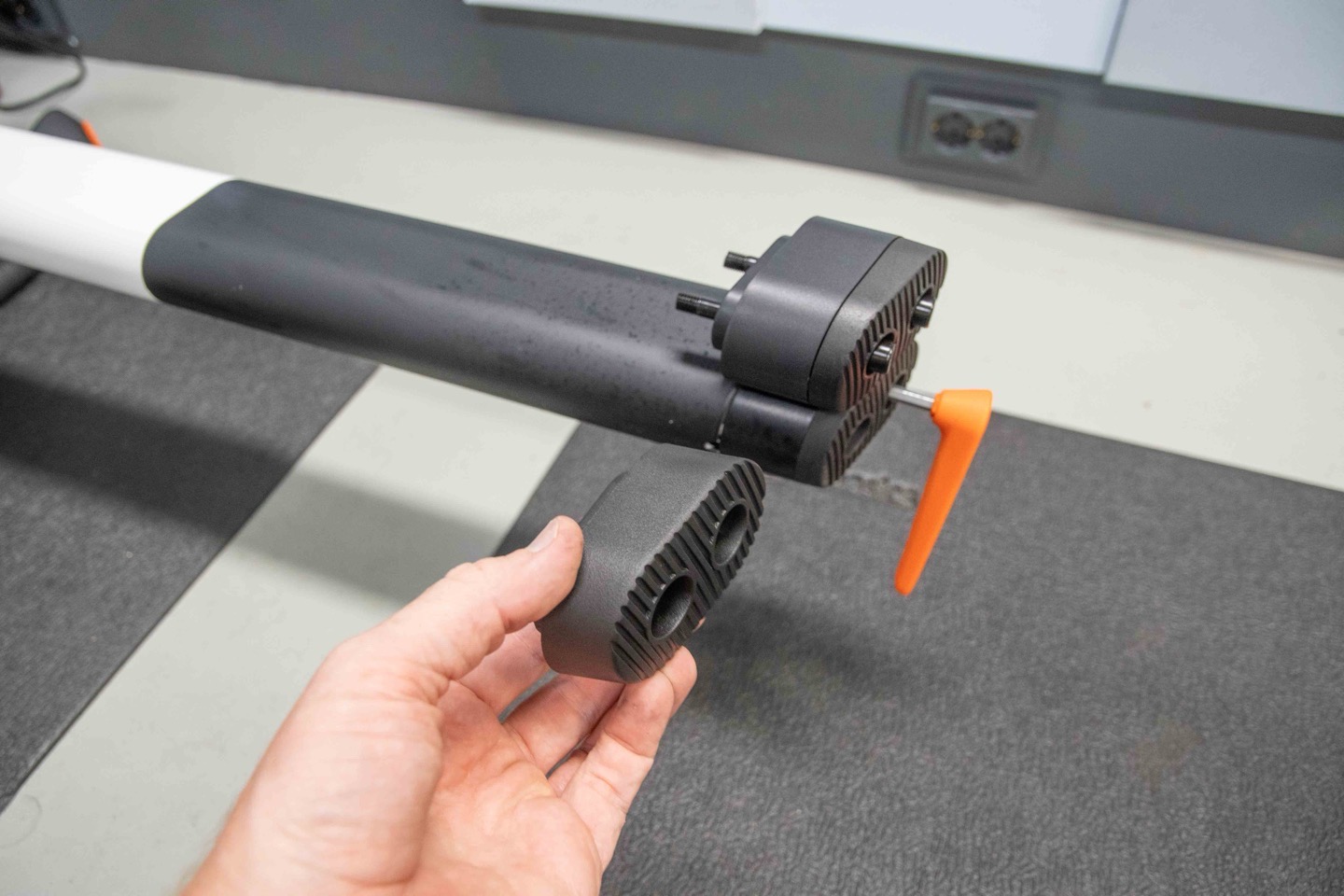
Oh, some instructions for fun (and to start scheming on how to attach a front wheel to it for the KICKR Move):
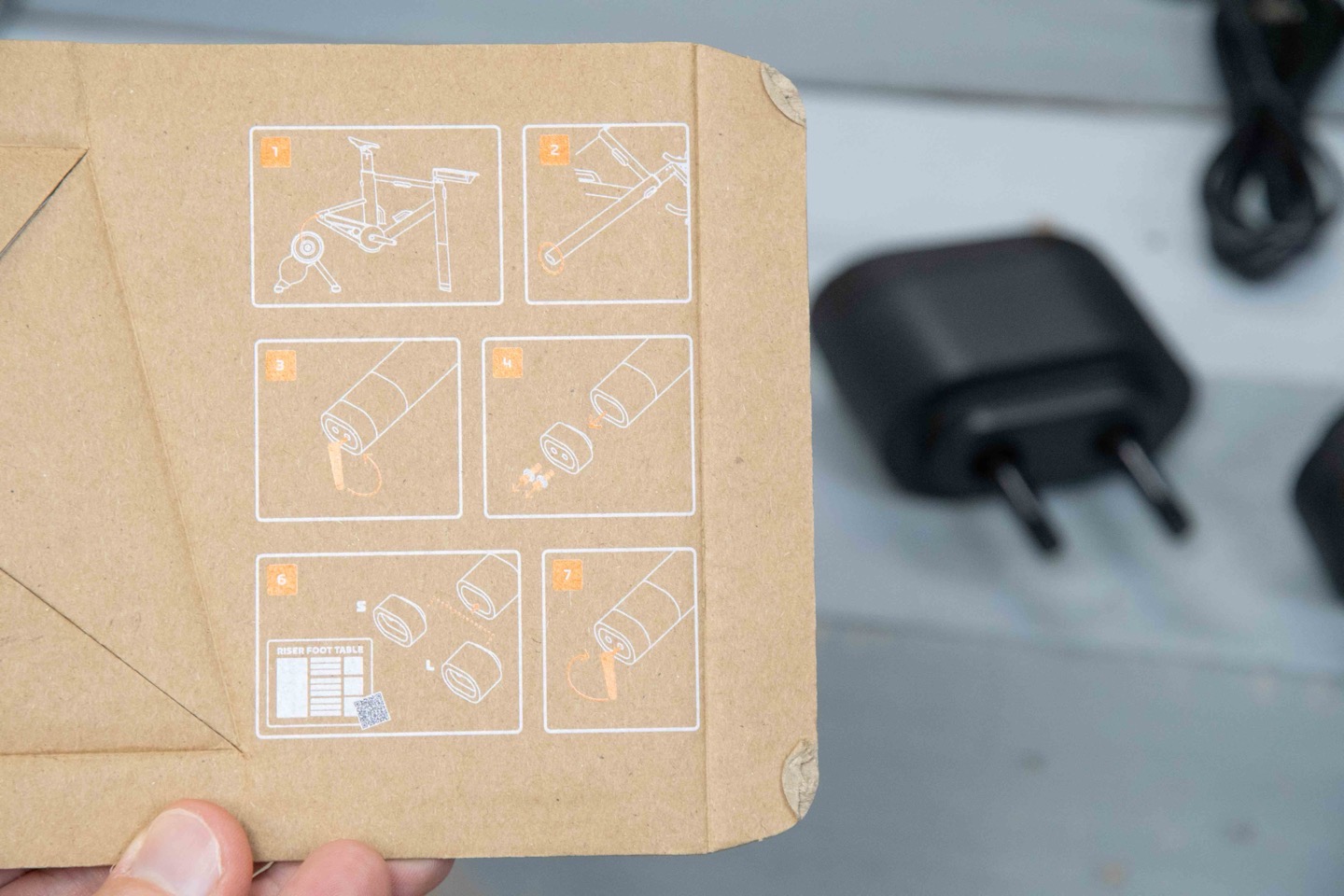
Here’s what it looks like with the Wahoo KICKR MOVE:
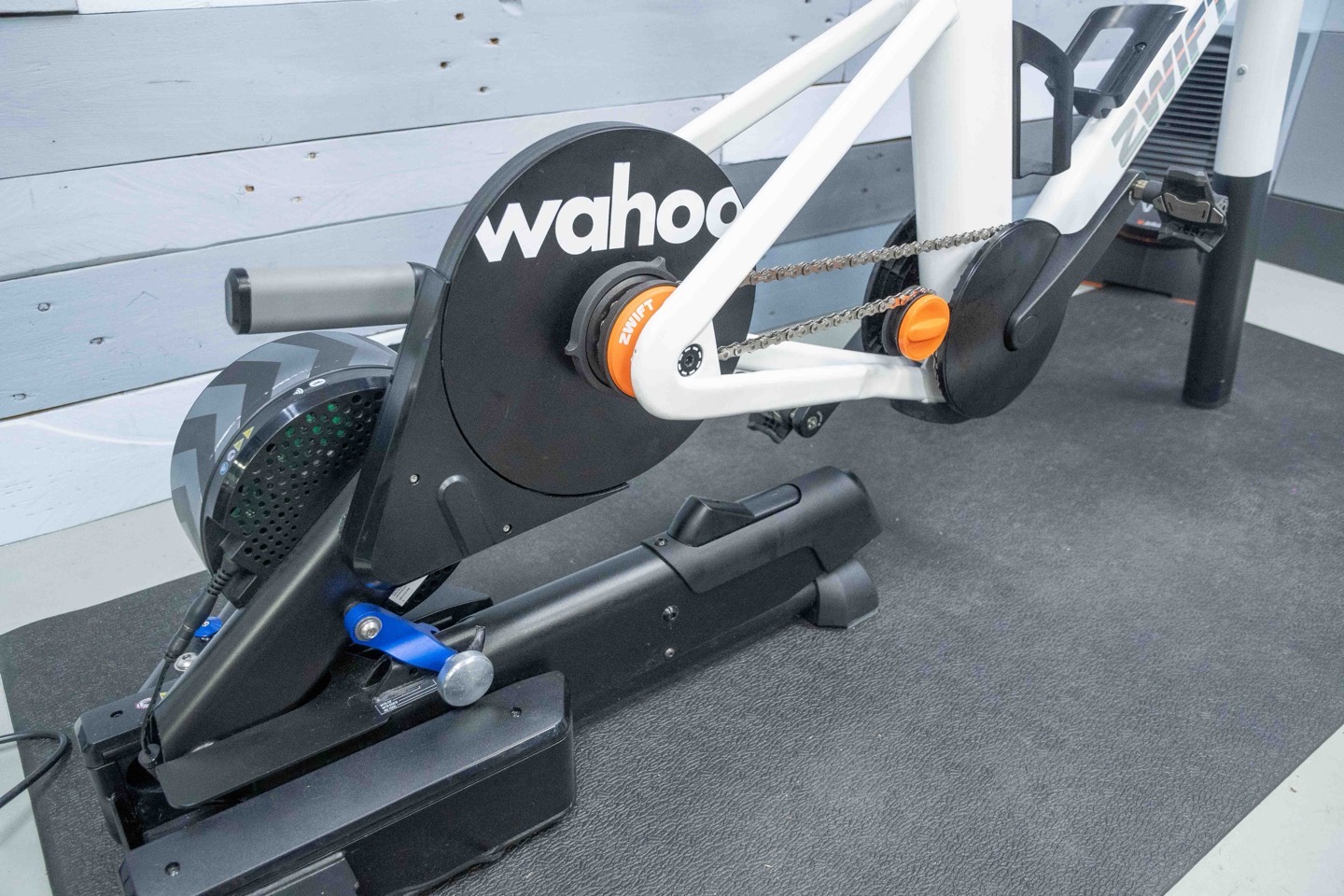
As I said before, setting aside the (very important) discussions around allowing 3rd party app compatibility with the virtual shifting, the general logic/design of a separate frame + trainer makes *FAR* more sense than a standalone smart bike for all parties involved. Far easier to ship (for companies), far easier to upgrade components over time (for consumers), far easier to deal with issues if something breaks (for consumers and companies), and generally speaking – all of that results in a far less expensive product.
Certainly, there are some minor complaints about Zwift Ride V1 in terms of crank length, or seat post forward/backwards adjustability, or a few other minor things. All valid, but all honestly easily fixed in a Zwift Ride V1.1 or V1.5 or whatever. Zwift says they’re keenly aware of the feedback in this realm. But for most people, the Zwift Frame + a trainer of your choosing makes an absolute boatload of sense, especially for multi-user environments. It’ll be interesting to see where both sides of this equation (Zwift Frame hardware, and various trainers) go in the future.
Now for pricing more broadly, here’s a table Zwift put together. I know it looks confusing, but that’s just because they’re trying to cover a slew of different currencies, as well as possible retail channels. This isn’t really aimed at consumers, but rather media/retailers, but I decided to include it, as it’s actually really helpful.

Got all that? Good.
Zwift Cog 2.0:
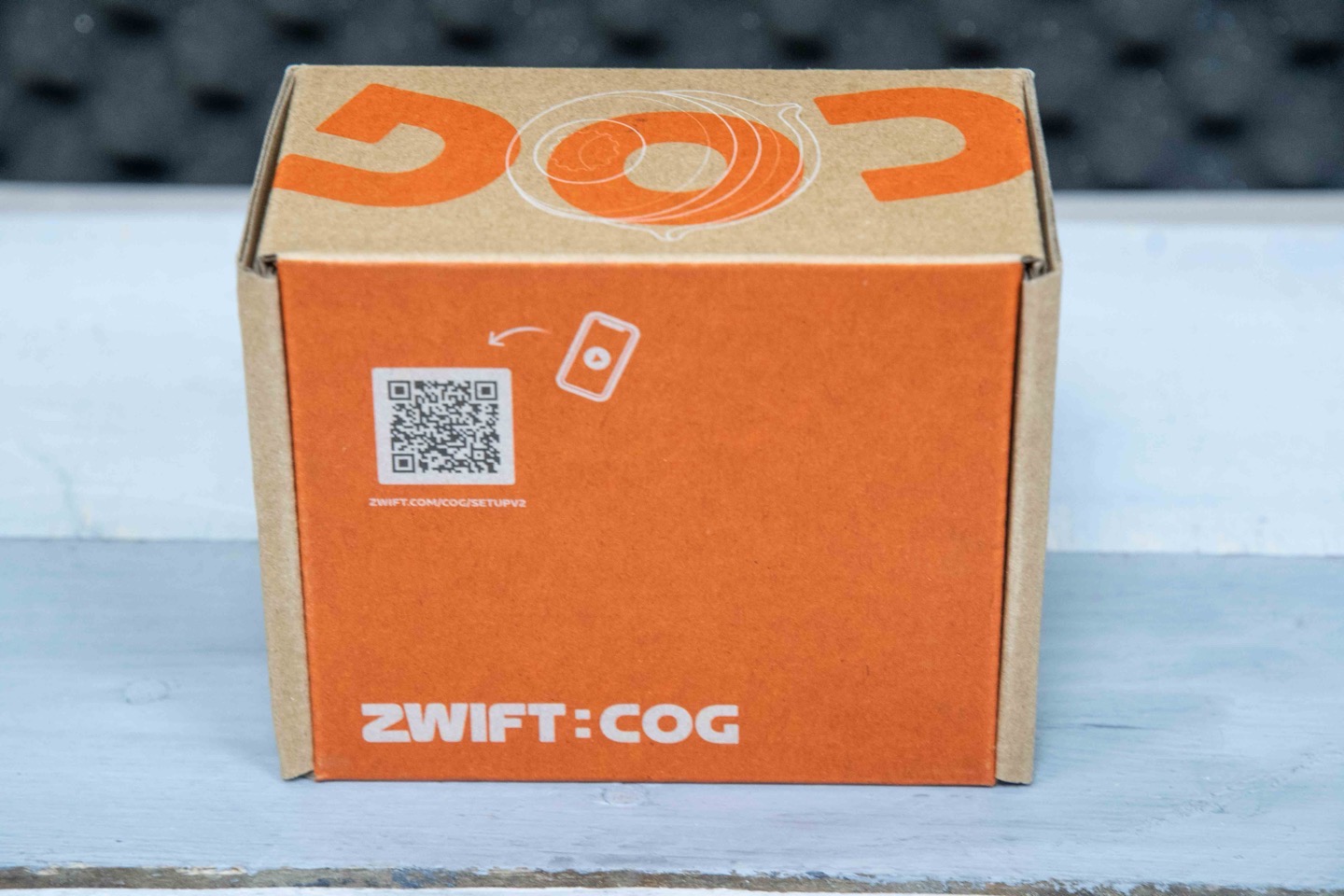
Next up, there’s the new Zwift Cog 2.0. Essentially, this adds the ability to adjust the indexing of the Zwift Cog to minimize any imperfections with your particular chainline. Said differently, with the previous Zwift Cog, you simply found a gear that was as silent as possible. Usually, that worked out. But in some cases, if you could have moved it an itty-bitty-tiny-bit one way or the other, you could have *nailed* chainline, and made it more silent. This now lets you do that, achieving much the same effect as adjusting the indexing on a normal rear derailleur.
The Zwift Cog is backwards-compatible to not just any previous Zwift Cog enabled trainer, but any future compatible trainer. Meaning, if you have a Zwift Hub or other Wahoo KICKR trainer that you’ve previously put the V1 version of the Zwift Cog on, you can upgrade to this one.
[Just in case you’re not familiar with the Zwift Cog generally speaking, essentially you use the Zwift Click button to virtually shift. Thus it’s a single-speed cog in the back, and all shifting happens via the Zwift Click buttons, not your shifters. This improves bike compatibility, though it only works with Zwift at present. You can read all about it in my past posts on it. The only thing changing here is the indexing bits.]
Here’s what a standalone Zwift Cog 2.0 looks like out of the box. In this current state, it’s nice and tidy, much like how a cassette is shipped:
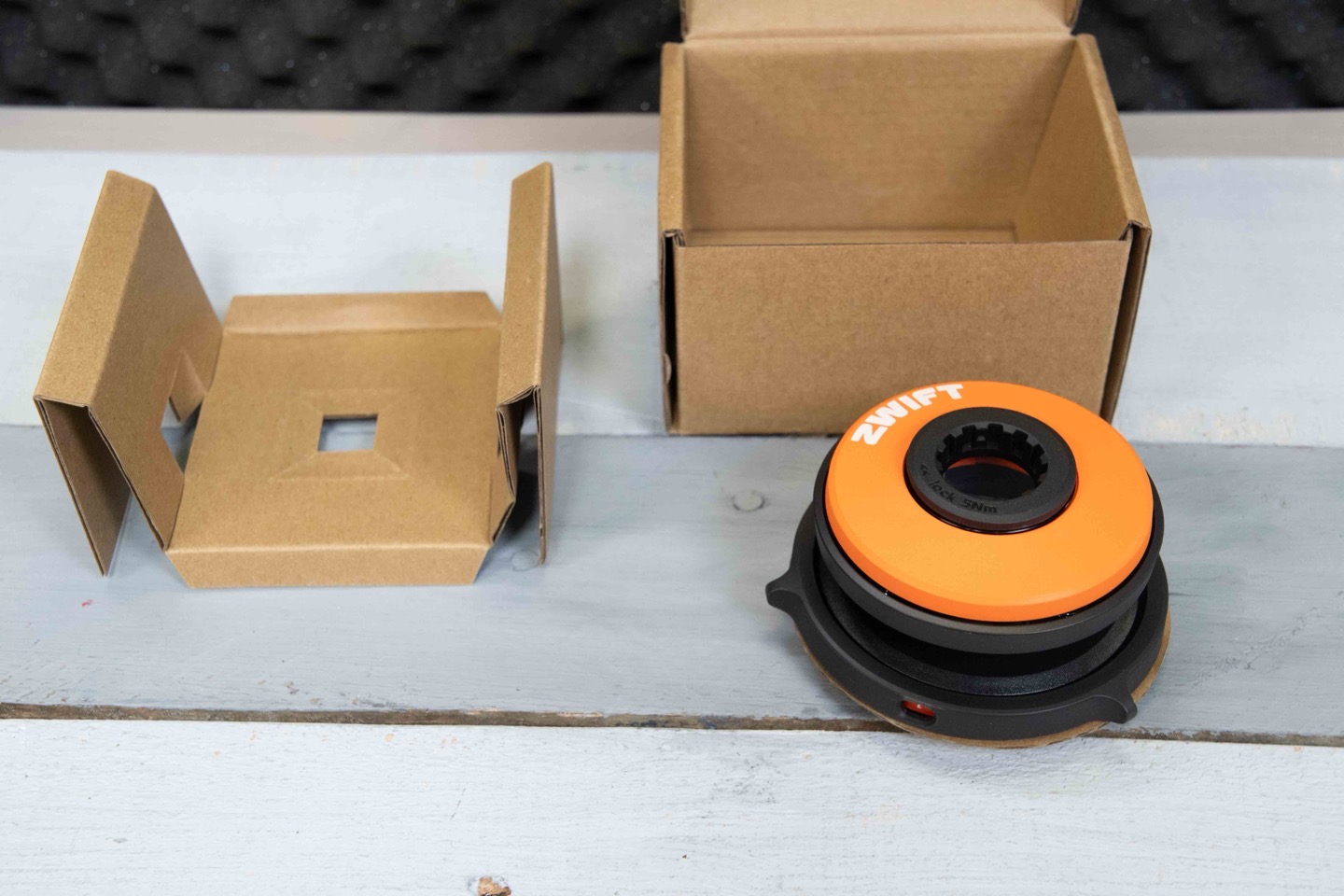
Or, in my hand, before I accidentally dismembered it:
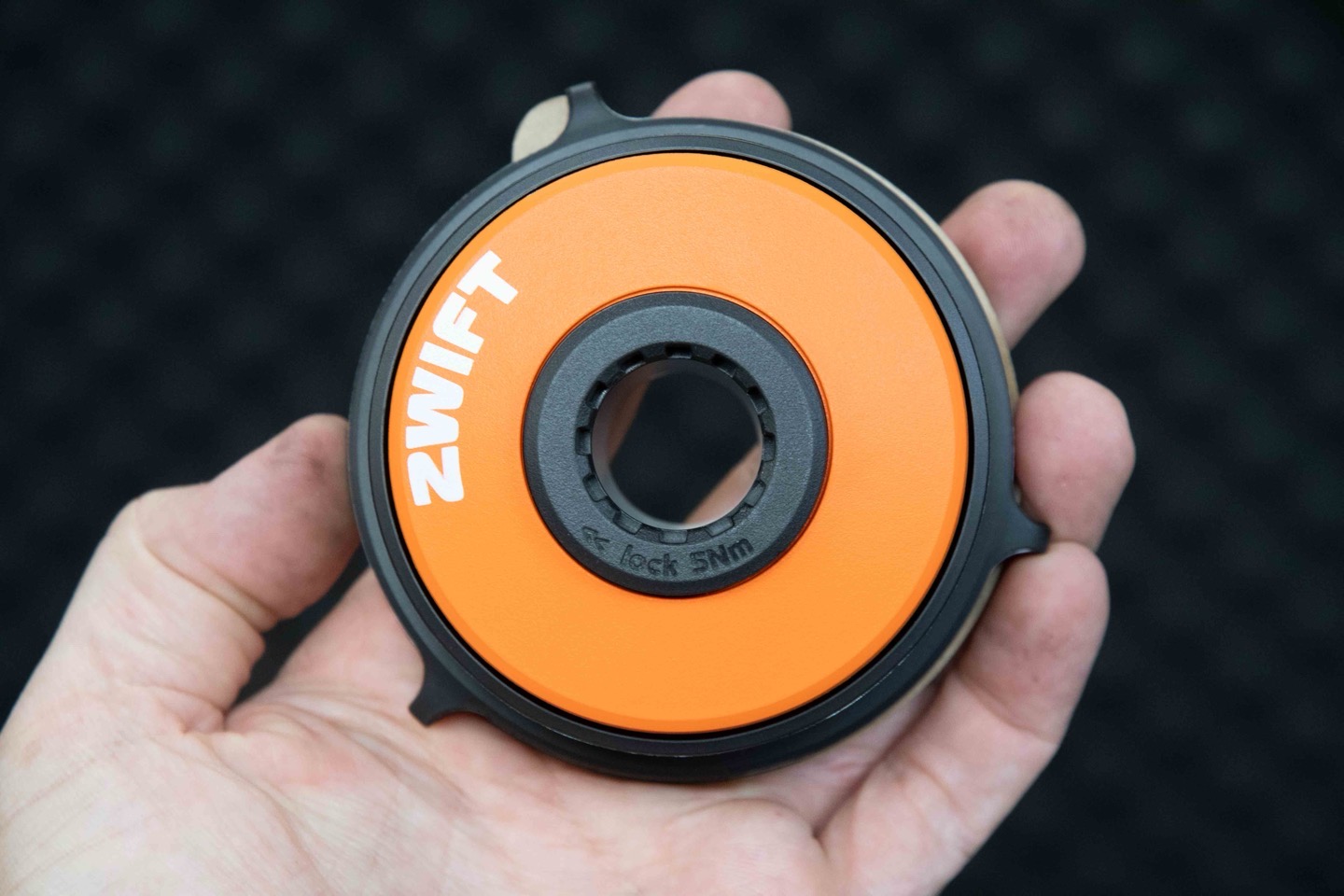
However, also like a cassette, at some point you’ll make the stupid mistake of taking apart the wrong plastic installation piece, and then you find yourself with umpteen pieces spread across the table. Probably not as tidy as this, because I decided to at least find value in the mess I had just made.

I very much did not intend on making the above photo. But basically, once you take out the cardboard piece, the entire thing just splays out over whatever surface was below it at the time (ideally not a sewer grate). Putting it back together isn’t hard per se, but just…mildly annoying. Thus, my life-learned lesson for you: Keep a firm grip on it till you slide it on the trainer.
Next, get rid of the old cassette on your trainer. In this case, I’m putting it on the Wahoo KICKR Move:
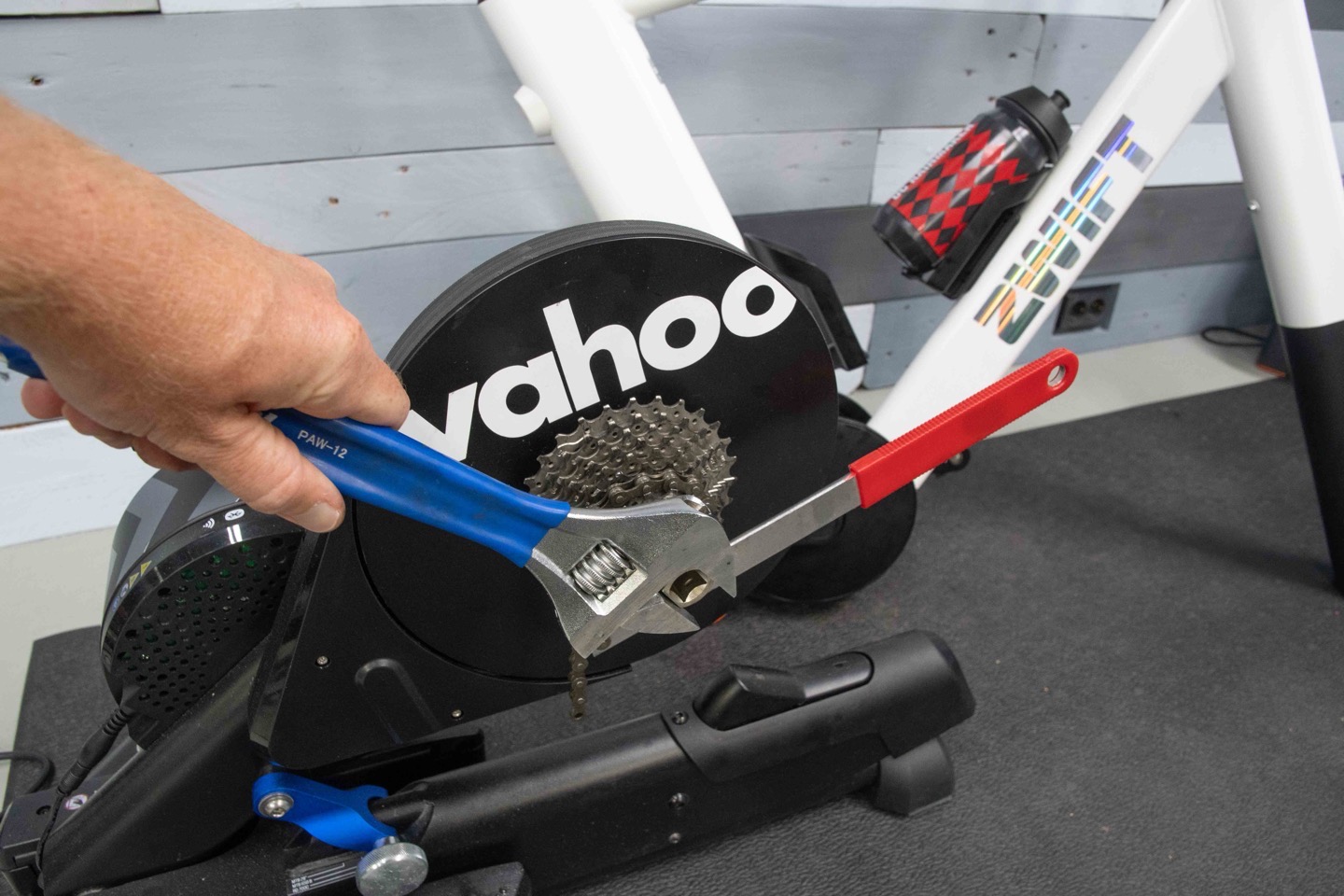
From there, you’ll slide it onto the free hub, and then use a standard cassette tool to lock it in place.
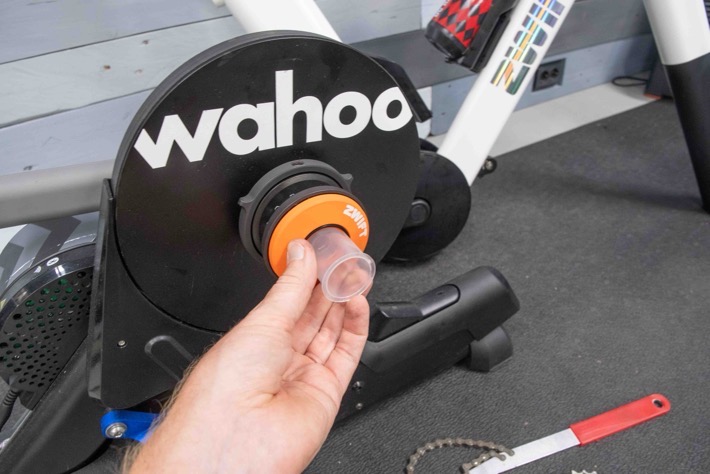
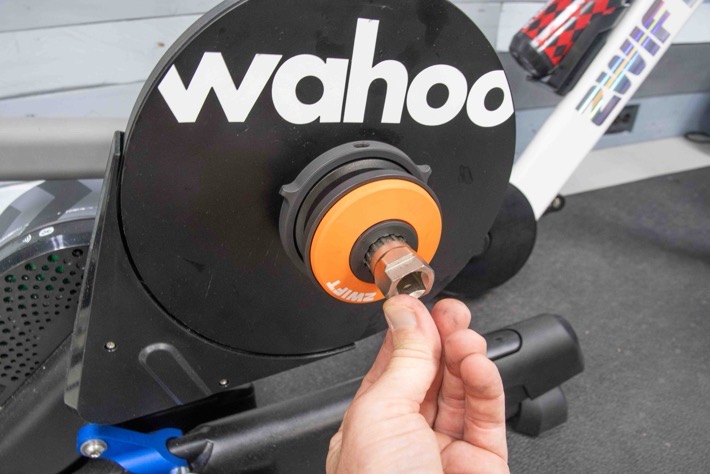
And with that, you’re done. As I showed in the JetBlack Victory trainer post, you basically adjust indexing across 11 different positions by simply rotating it. It’ll make a relatively minor click through each of those, till it gets to the last step, and then ‘whack!’, it’ll snap loudly back down to the zero position again (starting the process over again). You can see that little ‘bump’ below the ‘a’ in the Wahoo logo. That’s the piece you rotate to move between different positions on the cassette. This shifts the entire single-cog cassette piece either left or right laterally, adjusting to your chainline more precisely.
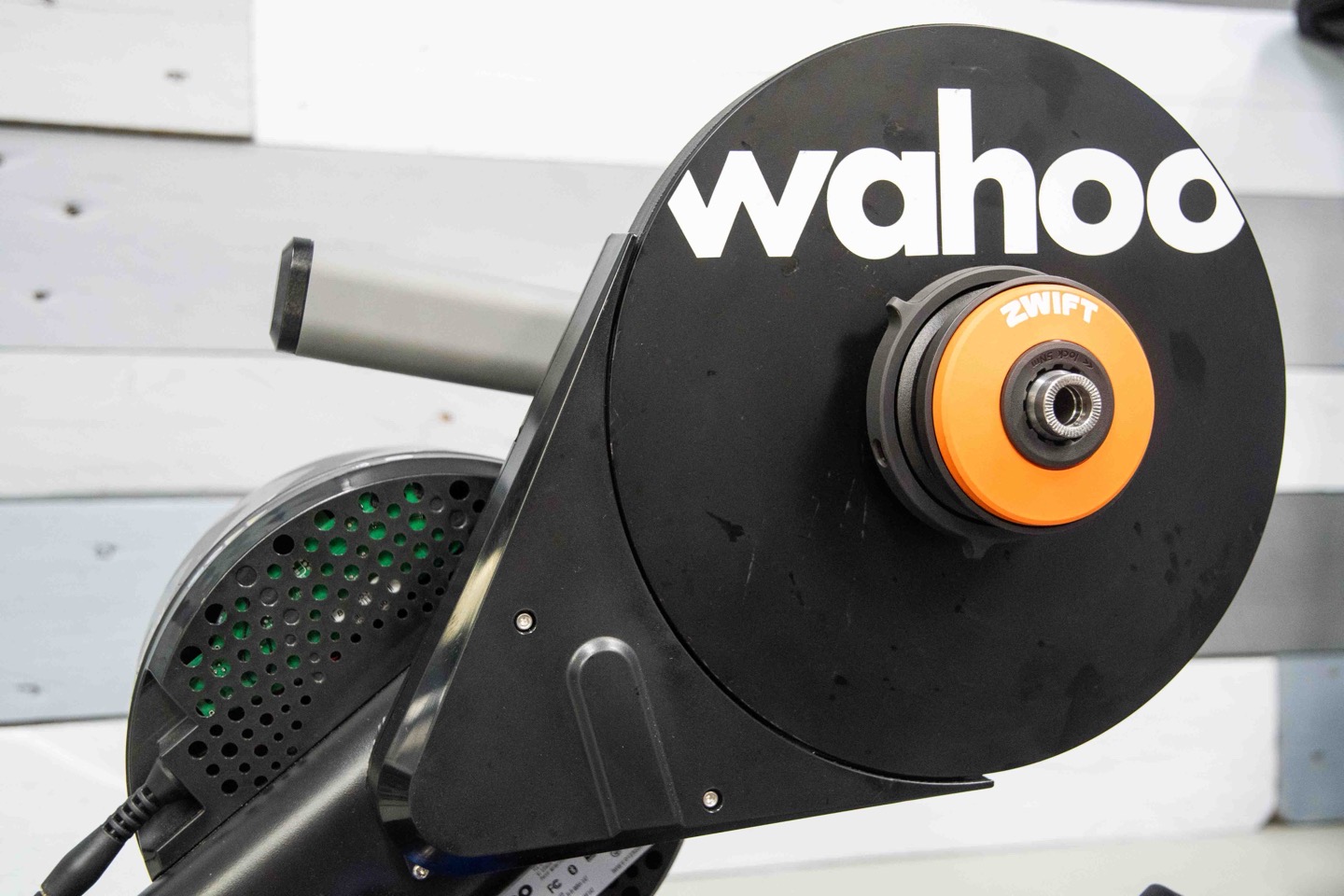
Here’s a picture of it on the JetBlack Victory, with the numbering more clearly visible, showing exactly which index number you’re on:
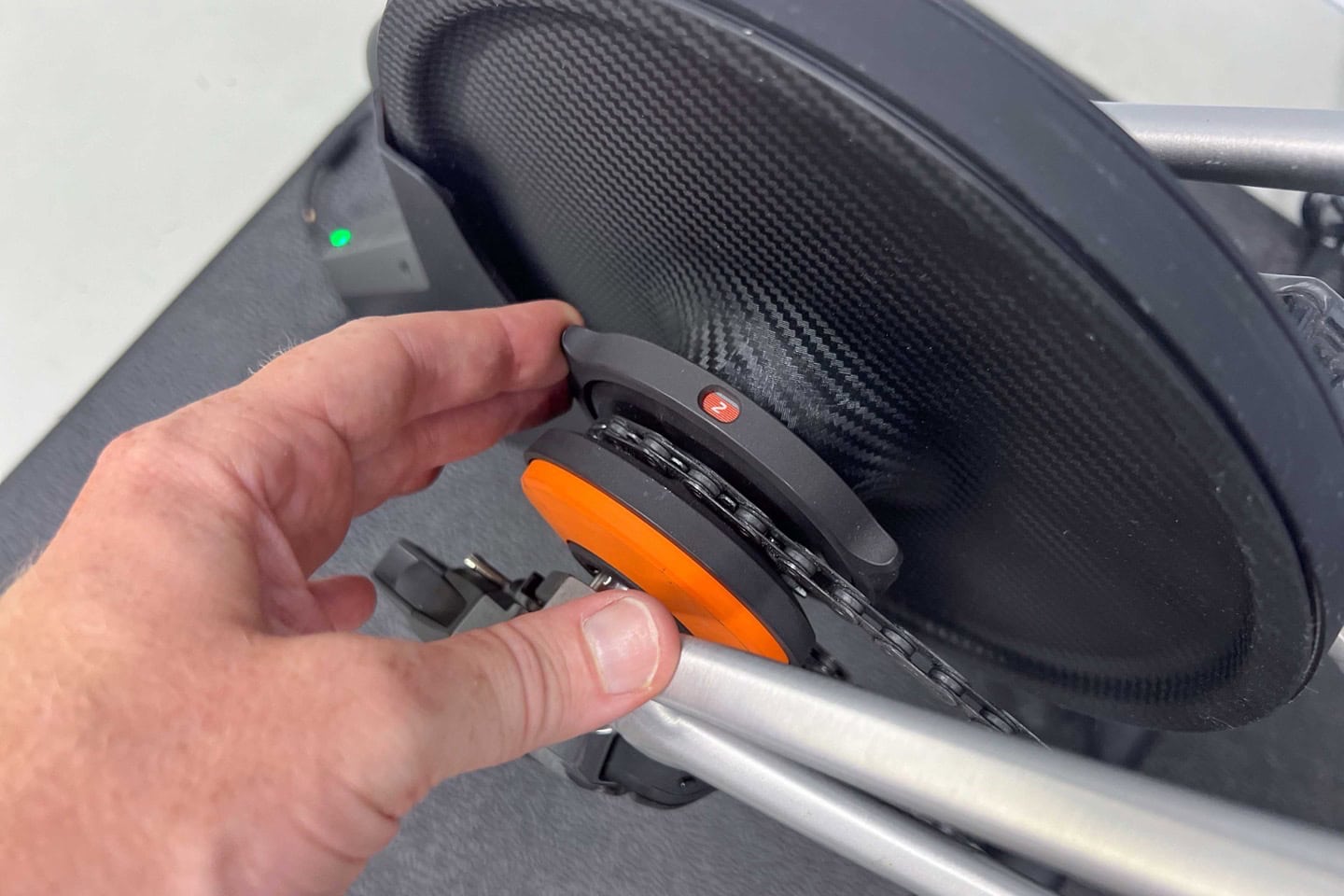
Finally, the pricing for the Zwift Cog 2.0 is $79.99USD/€79.99/£79.99/$109.99CAD/$129.95AU/¥12,500. That includes the Zwift Click, which, now gets some nifty new colorful buttons:

I don’t have the new colorful Click yet, so, above is a very orange widescreen image included in the Zwift media kit. Sure, I could have cropped it, but then that’d remove my ability to poke fun at it.
Zwift Ready Program:
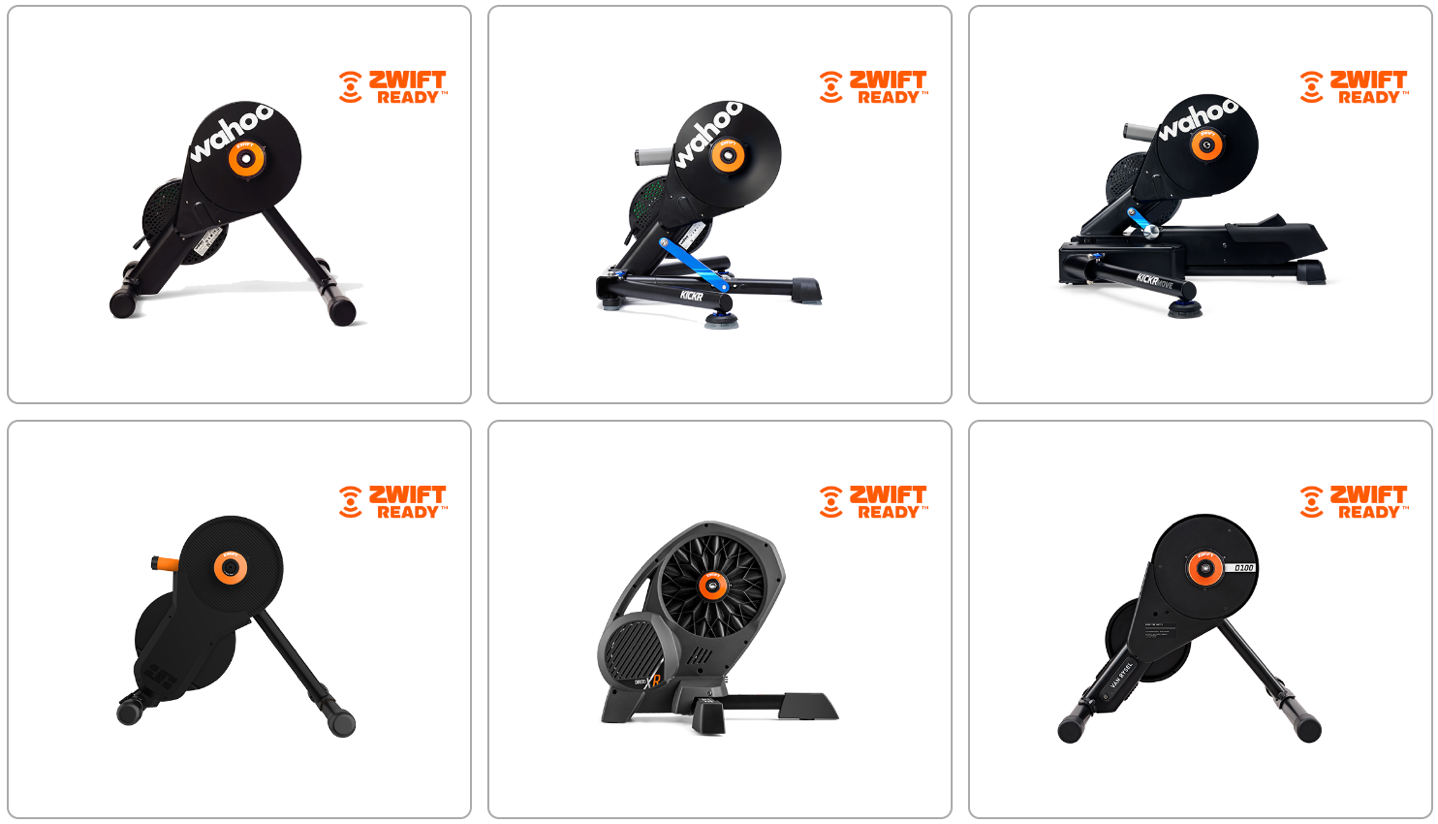
Now, just a quick note on what the new ‘Zwift Ready’ program is. That’s a newly launched branding, complete with it’s own very original WiFi-inspired logo, that indicates a 3rd party trainer is compatible with the Zwift Cog system (and by extension, generally the Zwift Frame). You’ll notice all of the trainers above include the new Zwift Cog V2, though practically speaking it’d be no different on Cog V1.
This is a different program than the previously attempted “Zwift Certified” program that…well…nobody’s really sure what that actually did. However, this new program is specifically looking at ensuring the trainer itself can properly respond to commands from Zwift to deal with virtual shifting.
Back many months ago I met with a few of the people (actual developers) that did Zwift’s virtual shifting. They noted that it’s a bit more than simply increasing or decreasing resistance on the trainer based on remote controller presses (e.g., Zwift Click or likewise presses), as Zwift’s implementation of it attempts to be both instant, but also feel more realistic from an inertia standpoint. And it’s true, having tried other virtual shifting implementations by other companies, Zwift’s implementation is by far the best. But that also means that some of that work is per-trainer model, rather than being a generic thing (whereas other companies are more generic, and thus, you get a more generic feeling).
Of course, as I’ve been beating the drum many times, Zwift could open up Virtual Shifting to both other trainer platforms as well as trainer hardware (they’ve done the hardware piece already). That’s a key piece that other trainer hardware companies are waiting on, to avoid locking in their users to the Zwift platform.
In any event, what’s notable is that Zwift Ready is purely focused on the compatibility with the trainer side of virtual shifting. In fact, it doesn’t deal at all with smart bikes that might want to have Zwift Ride-like controllers (with special Zwift buttons), such as a few are developing (including for the Muov Bike). Nor does it certify that the trainer is accurate, or anything else. Zwift hasn’t gotten into the business of accuracy testing, or reliability testing. Nor does it do really anything else, except confirm that the trainer meets the specifications of Virtual Shifting, and passes basic tests there.
There’s nothing wrong with that, but I figured I’d placeholder it here on exactly what it’s covering.
With that – thanks for reading!
FOUND THIS POST USEFUL? SUPPORT THE SITE!
Hopefully, you found this post useful. The website is really a labor of love, so please consider becoming a DC RAINMAKER Supporter. This gets you an ad-free experience, and access to our (mostly) bi-monthly behind-the-scenes video series of “Shed Talkin’”.
Support DCRainMaker - Shop on Amazon
Otherwise, perhaps consider using the below link if shopping on Amazon. As an Amazon Associate, I earn from qualifying purchases. It doesn’t cost you anything extra, but your purchases help support this website a lot. It could simply be buying toilet paper, or this pizza oven we use and love.






















Hi Ray,
Given the incompatibility of virtual shifting with anything not Swift does it mean that we’ll never see Tacx NEO series being compatible with Cog/Frame given the fact that Garmin has their own indoor cycling system in Tacx complete with all the workouts and videos?
I wouldn’t say never. Rather, I suspect Garmin would want to see a bit more openness in a Zwift Cog implementation before they commit. I suspect they could extract (easily) Zwift agreeing to Garmin being able to put Virtual Shifting/COG with the Tacx App, but I think that’d be a confusing thing to message to users, especially ones expecting Garmin’s usual stance of working with everything.
Thanks for the update! Just to be sure, the older kickr Cores with cassette are also compatible after you swap out the cassette for the cog? Any software updates needed afterwards?
I have another question regarding Garmin. If I use my Fenix 7 to control my Kickr my doing one of the Workouts suggested by the watch, does this work with the Zwift Cog?
Is there any vision toward a mod to bring kickr climb compatibility? Or a possibility that Zwift would sell the handlebar control only?
Zwiftinsider.com commented to use old inline skate shoe or sth like that
FWIW, after you buy the Ride Frame they list the two components separately. One piece is called “Zwift Ride Smart Frame” for $480 and the other one “Zwift Ride Handlebars” for $319.99.
Not sure if that means they might sell the handlebars separately. Also not sure if many people would pay $320 + shipping & tax for them.
But handlebar control is essentially the same thing as Zwift Play controllers, just built into the handlebar instead of being two separate pieces you attached to the handlebar.
If only this frame accepted f&b derrailleurs and a standard bottom bracket. I’d be begging them to sell me one.
Virtual shifting is nice and all, but the biggest drawback for me is that even if you’re willing to give up on virtual shifting, this still can only be used with Zwift. Which I reckon makes sense, as this is their product and it’s in their interest to platform-lock it.
I just wish some product like this one will eventually make it to the market, just as aesthetically pleasing and convenient, while supporting being used with other applications that require actual gears.
Feature-wise, Caveworks Rivet ticks all the boxes. But for all its features, it’s very aesthetically challenging.
Ray,
I’m going to apologize up front for asking you for predictions, but I can’t help myself: do you foresee the Elite Suito getting invited to the Zwift Ready party? I’d much prefer to go in for the Zwift Frame than Craigslisting it and buying the full Zwift Ride package.
¯\_(ツ)_/¯ is an acceptable answer.
Thanks!
Ray, any chance that Zwift releases the brifters from the Zwift ride alone? I like how neat the controls are compared to just adding Zwift Play to an existing set of handlebars since I have a dedicated indoor bike.
Ray, thanks for this update! Does the Zwift Frame fit and work with the Wahoo KICKR Core from 2020?
does the Zwift Ride comes with cog 1.0 or cog 2.0?
The Zwift Ride Frame comes with the V2. I believe the Zwift Ride with Kickr Core bundle comes with the V1, as they are just sending the existing trainers that have the older cog already installed.
I was looking into that as well. Isn’t it then not “better” to buy the frame and Wahoo kickr separately? In the end the same price, but you’l gt the V2 and with the Wahoo the Zwift click is included.
Kind of ironic that the “Zwift Ready” moniker really means “incompatible with non-Zwift apps”, whereas without, it is still actually Zwift ready ;)
Any insight on whether Zwift will allow configuration of the buttons on the wahoo kickr bike shift, and also the displaying of the gear in app?
Did the new foot of the Zwift Ride change the possible range of the handlebar height? I noticed a strange difference on Zwift’s website: “Handlebar Height Min-Max: 94 – 110 cm” (link to eu.zwift.com ) versus a minimum of 86,3 cm (adding up D = 600 mm and J = 263 mm, on link to cdn.shopify.com )… Which one is correct?
I have the Zwift Hub 1 Smart trainer. Im thinking of purchasing the Zwift Bike frame but do I really need the orange cog if my Hub 1 is compatible.
Hi Ray
Are you aware of any update from Wahoo on bringing virtual shifting to Kickr v5 and potentially older models as they announced originally? That Zwift Ride Frame looks attractive, but only if one can keep the existing trainer…
Thanks,
Michael
I’ve been following the Zwift Frame developments and I’ve been seriously considering a smart trainer for a while. I currently have an old Giant OCR2 mounted on a Tacx Vortex. Its worked well for years but because of how much I sweat, the front derailleur often freezes up on the bike (which is why I’ve considered a smart trainer).
But is there any advantage to getting the Zwift Frame + Jetblack Victory over just using my old bike? If the Zwift hub is doing all of the heavy lifting, is there something I would be missing? The price point of the Victory is very appealing (the expense of the smart bikes are what have really prevented me from pulling the trigger)
Thanks, another really helpful post. I’m in Australia and was just about to buy the Zwift Ride with KICKR CORE package which comes with the Zwift Cog v1… is it worth waiting for the Zwift Cog v2 and adjustable front leg frame to be available in Australia or does it make no difference if riding with the Core as provided?
Does the Zwifg Cog v2 release mean that any direct drive trainer is compatible now? Or is it still only the trainers listed as Zwift Ready? I have an Elite Suito and have been itching for this because I need to replace my cassette anyway, so I just ordered a Cog v2 in hopes that it will work, but it’s very unclear if it actually requires one of the trainers specified.
Can anyone comment on technical reasons why a kickr v5 or any other direct drive trainer wouldn’t be compatible with the cog and click and any app couldn’t implement? Seems like with the hardware in place zwift would just have to command the trainer to increase or decrease the resistance a set amount for each virtual gear (and then do the wattage calculation as the resistance x trainer speed with any additional slope or multipliers)…and any other app could do the same as long as there was a method to command the virtual shift?
As far as I understand what Zwift has created is a new protocol rather than a clever way to use existing protocols (FTMS).
So, in the case of Zwift and trainers, the trainers need firmware which understands the proprietary control protocol, but for any other app, they could use FTMS or Ant+ FE-C to control a trainer as a virtual shifting device?
Seems anti-consumer and I hope another app will release a virtual shifting option that uses the standards-compliant methods while also gaining market-share.
FTMS doesn’t have a virtual shifting functionality. What a third party app can do is adjust the resistance in a clever way that is supported by FTMS (think it like a dynamic trainer difficulty).
Also, third party apps aren’t supported by Zwift’s buttons so you still need a way for the user to input a change of gear.
I might be repeating a question – Can the Zwift be Cog work with non Zwift Ready trainers? That is install it on a Tacx Neo. I under the shifting works inside of the Zwift app which transmits the resistance to the trainer. Also, what chains is it compatible with?
I’m looking for one like that for me and my wife.
The only concern I have and which I haven’t been able to resolve yet is, can the bike be used without Zwift?
My wife wants to use Zwift, but I just want to watch a film in peace while cycling. Will I be able to change gears then?
Is that possible?
This whole discussion got me thinking that you don’t really need the Zwift cog at all but just the Zwift click buttons…
To do what exactly? I’m curious to understand: what do you expect/hope to do with buttons if you have a normal cassette?
No more „real“ shifting needed. Creates less noise indoors and you can keep the chain in the „ideal“ chain position all the time
Just built up the frame with cog v2 and on my kickr v6 the cog is badly rubbing against the frame. The lock ring protrudes out so much that it rubs against the frame creating to much friction to properly use it. Ever heard of this issue?
I was wondering if ordering a KICKR v6 with the Zwift Ride would overcome the HR sensor “issue” when paring the setup with an AppleTV because the KICKR v6 is capable of using WIFI to connect and therefore freeing up an bluetooth channel on the AppleTV. Thanks in advance and keep up the great work!
Asking the experts:
will my Wahoo Kickr 2018 ever be compatible with the Swift Ride – or do I have to accept the fact, that my Smart Trainer is just too old for that?
Hey Ray,
Not sure if it’s in this thread, but do you know if the Cog V2 works with the original Zwift Hub V1 and Zwift play?
Yes, it does.
Technically speaking, there’s nothing in the Zwift Cog V2 from a powered chipset/technology standpoint. The only difference is the physical thingy that let’s you inde your chain. So, Zwift/etc is none the wiser, and from a mounting standpoint, identical.
Hi Ray. I am interested in using the Zwift Ride frame on my trainer (an Elite Justo) and use it only in Erg mode. I am not interested in virtual shifting so the software compatibility between Zwift and the specific trainer is not a concern for me. So, is it possible to remove the cassette from my trainer, fit the Zwift cog and then fit the Zwift ride frame? on it? From wI got the impression What do you think?
Been a Zwift user for years. Bought the Zwift ride. Delivered the other day without the cog 2 or the wires for the handlebars. Tried going on Zwift site. It’s designed to not involve any human responsiveness. Ultimately sent email. Time will tell. But total fail. Buyer beware.